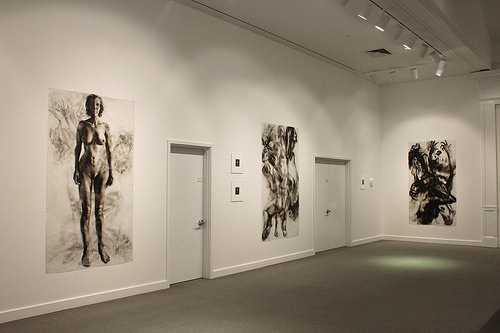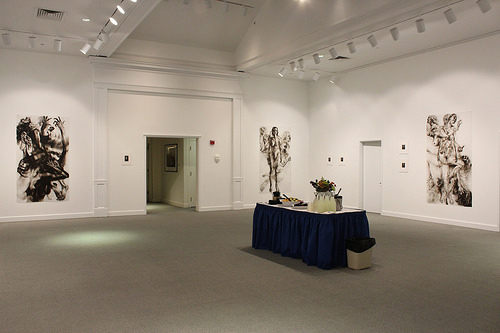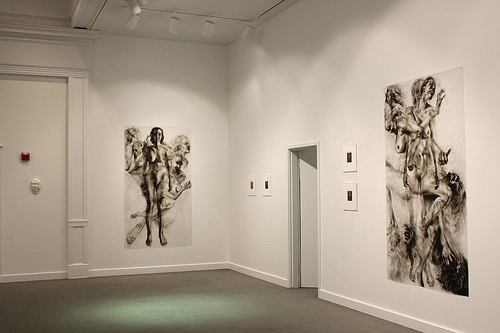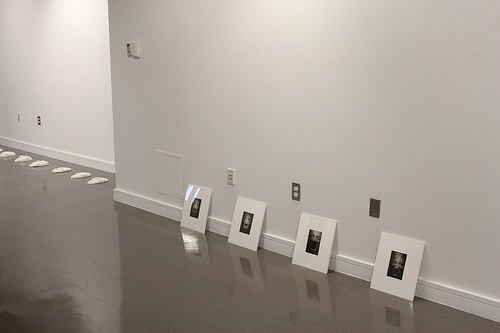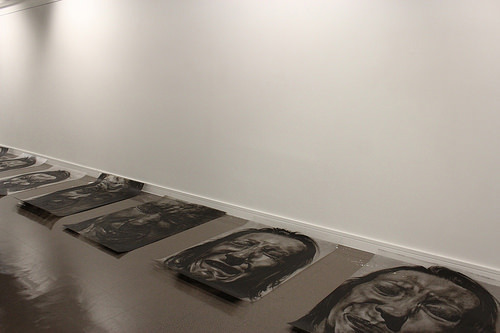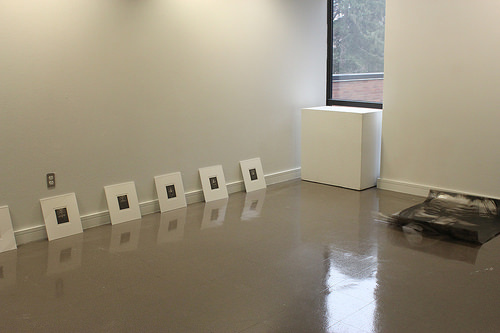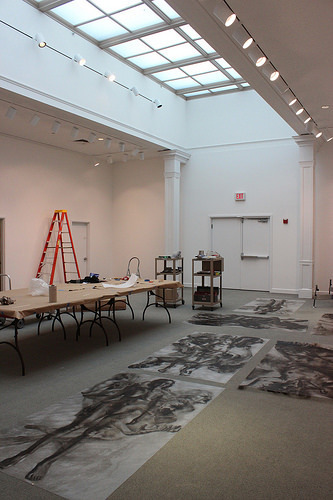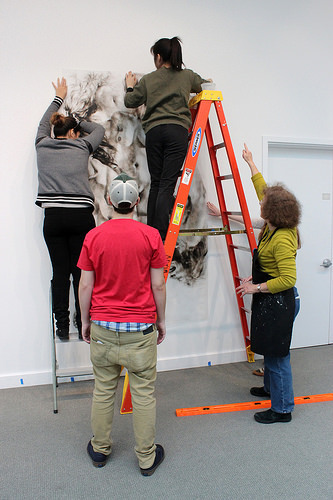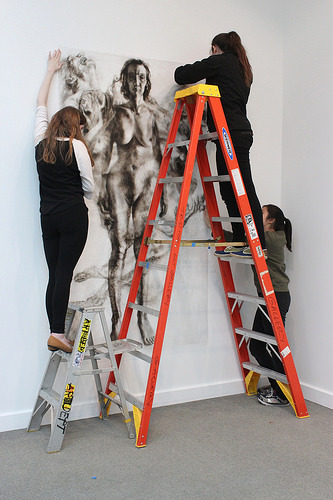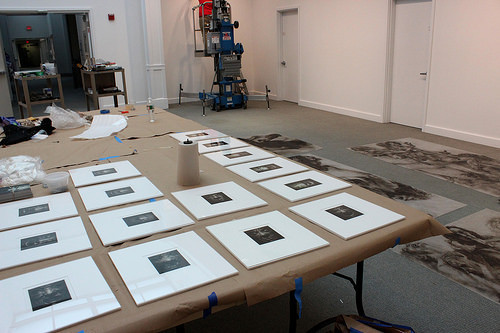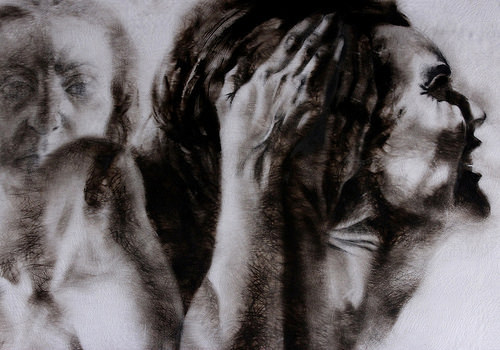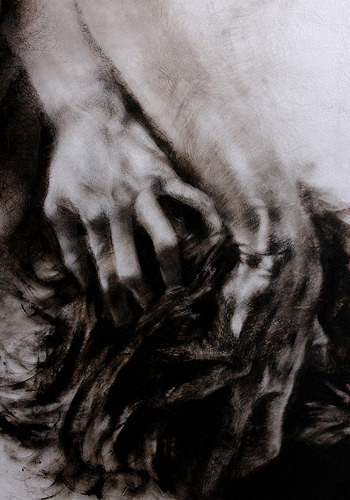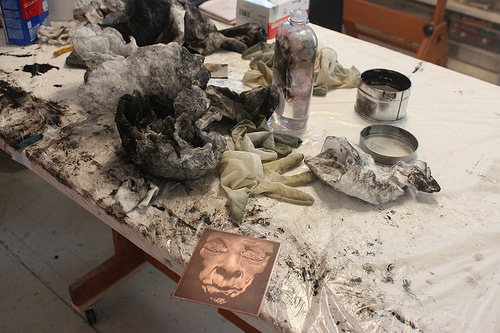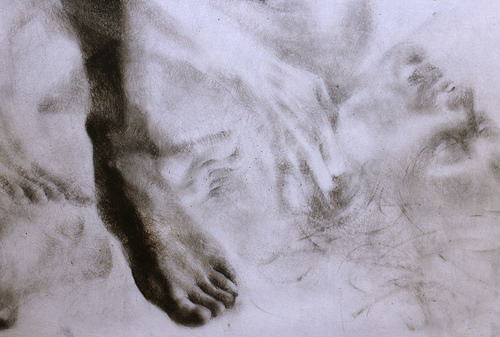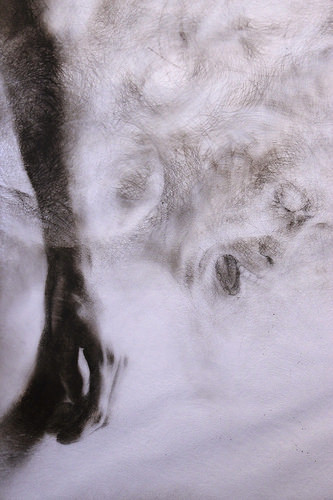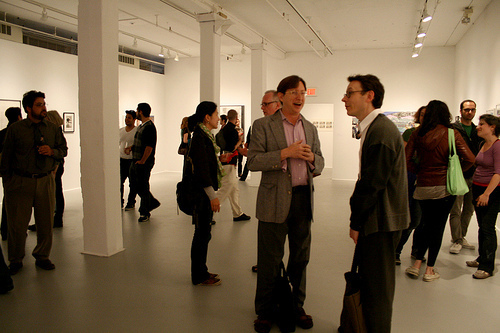Clara Lieu's Blog, page 29
November 13, 2014
Opening reception at Simmons College
Last night was the opening reception for my solo exhibition, “Emerge” at the Trustman Gallery at Simmons College. Several of my colleagues from the various schools I’ve taught at were in attendance, going all the way back to when I was at Concord Academy, the first teaching job I had out of graduate school. Thanks to everyone who came out for the opening!
The exhibition is also listed in the Boston Globe this week. Art critic Cate McQuaid writes:
“Lieu makes 3-D work as a basis for drawings, prints, and photos. In her elegant, volatile large-scale prints and drawings, figures struggle, monsters lurk, and a mythic tale unfolds.”


November 11, 2014
Installation day at Framingham State University
I installed my solo exhibition at the Mazmanian Gallery at Framingham State University this morning, my third and final solo show installation of this year. After having installed the exhibitions at Simmons College and Sarah Doyle Gallery, installing this show felt like clockwork. I’ve figured out a good system for hanging the work, and I troubleshooted all of the potential issues early on. This made for a very smooth and easy installation. I had the help of the gallery director as well as two students, and we were able to hang the show in just three hours. The opening reception is next Tuesday, November 18 from 4:30-6:30pm.


November 7, 2014
Installation Day at Simmons College
Today was the day I’ve been working towards for almost a year: I delivered my work to the Trustman Gallery at Simmons College where I worked with the gallery director and a wonderful crew of 5-6 students to install my solo exhibition, “Emerge“. It was incredibly helpful to have so many people installing the show. The 7′ x 4′ figure drawings were large enough that each drawing took about 3-4 people at a time to hang the piece. The mezzotints and prints are small, but they require a huge amount of precise measuring to be sure that everything is level and spaced properly on the wall. This is where my years as the gallery director at the Jewett Gallery at Wellesley College is extremely useful. I have a lot of experience installing many different kinds of shows, so when it comes to installing my own work I feel like I know the process inside out from beginning to end.
All in all, we installed 6 large figure drawings, 3 sculptures, 5 photographs, and 10 mezzotints, definitely the largest quantity of work I have ever shown in a solo exhibition. The quantity of work I had fit the space perfectly, which was very lucky as that’s something that you can’t predict. I brought more artwork than I thought I needed, and we ended up hanging everything.
The opening reception is next Wednesday, Nov. 12 from 5-7pm. I’ll be giving a 15 minute gallery talk at 5:45pm as well. You can RSVP to the opening reception on Facebook here.


November 5, 2014
Artscope magazine article
I am featured in an article written by Elizabeth Michelman titled “On Her Own Terms” in the November/December 2014 issue of Artscope magazine. You can read half of the article at this link. For the full article, you can get the print issue for free, usually around Boston area art schools and art venues.


November 4, 2014
Upcoming Lecture at the Cambridge Art Association
I’m giving a lecture at the Cambridge Art Association on Friday, Nov. 14, 12-1pm. The lecture is based on my book, “Learn, Create, and Teach: A Guide to Building a Creative Life.” The lecture is a part of their “Lunch and Learn” series and will deliver succinct, practical, and candid advice that addresses both common concerns in the creative path and the real-life challenges an artist faces in the real world.
The lecture is $20 for CAA members, and $25 for non-members and includes lunch. You can register at this link.


October 29, 2014
A free moment
The large figure drawings have been photographed and posted on my website, the prints and photographs are at the framer, and my studio is set up and ready to go for Waltham Mills Open Studios this weekend. For the first time in months I don’t have any pressing work that needs to be done immediately. I’m taking some time this morning to breathe momentarily before the wave of installations, opening receptions, and gallery talks begins next month.
My advice column “Ask the Art Professor” has been on hiatus for the past two months while I prepared for my exhibitions. Now that the exhibition work is complete, I’m going to work on getting the column up and running again. I have missed working on the column, so it will be nice to get back to writing.
I’ve also made two local contacts who have agreed to provide consultation on my idea for creating a series of video tutorials. One meeting is with a small local production company, and the other is with someone who has worked in public television. At this point I’m just interested in knowing what my options are, and what kind of logistics might be involved. I probably don’t know what I’m getting myself into, but it’s very refreshing to enter a new field which is completely unknown to me.


October 25, 2014
Open studios: Artists and visitors
Waltham Mills Open Studios is just a week away, so I am starting to prepare for the event. Last year I wrote a blog post, titled “12 ways to prepare for open studios” that makes concrete suggestions for artists getting ready for an open studios event. I revisited my list to be sure that I am on top of every detail.
I’m always thinking about ways that I can improve the open studios experience, both for myself and my visitors, so this past week I’ve been brainstorming some potential strategies. There is one aspect of open studios that I’ve always found to be at times awkward for both the artist and the visitors. Inevitably, there are moments when your studio is empty, and then you get one or two visitors who walk in and you’re just standing there by yourself, watching them as they enter. This can awkward for the artist, because you don’t want to come on too strong and force a conversation your visitor doesn’t necessarily want to have. On the other hand, ignoring your visitors doesn’t seem polite either. From the visitor’s point of view, this situation can be uncomfortable because you can feel pressured to make conversation with the artist. When the studio is empty, and it’s just you and the artist, you can’t just wander at your own pace the way you can when the studio is full of other people. In the past, when I’ve visited other artists’ studios at other open studios events and this happens, I get anxious that the artist is scrutinizing my actions, and I feel pressured to linger longer so I don’t offend them by leaving too quickly. I’ll admit that there have been times when I’ve visited an artist’s studio, and realized within minutes that I’m not interested in staying. If the studio is crowded, it’s really easy to slip out quickly without feeling like you’re going to offend the artist with your very brief visit.
So I’ve been trying to think about what activity I could be actively engaged in during the event that wouldn’t require too much concentration on my part, that visitors might be interested in seeing, but that would also keep me accessible to my visitors. Then it occurred to me that I could demonstrate printing some mezzotints throughout the event. I have yet to edition these mezzotints, so it’s something I need to be working on anyway. This would allow my visitors to watch me in action, and provide some insight into how the work is made. Printing the mezzotints is a purely technical process; I don’t have to concentrate very hard to do it and I know I will be able to talk to people and answer questions at the same time. I can also stop and easily pick up from where I left off. (by comparison, I could never do this while I was drawing) It’s an experiment, I’ll try it the first day and see if it works!


October 21, 2014
Scraping
This sixth and final drawing that I’ve been working on recently has proved to be more work than I initially thought. With the exception of the central standing figure, the other figures in this drawing are extremely light and suggestive. I thought for this reason that it would be less work. On the contrary, I discovered that the quickest way to get the subtleties I was looking for was to “overdraw” the figures and then scrape them down. It was really difficult to directly smear the etching ink in a subtle manner, so the only way I could get the lightest tones was to scrape with the x-acto knife. I’m sure I spent more time scraping than I did actually drawing with the etching ink.
I did finish this drawing today, which felt terrific. This means that all six large scale drawings for my upcoming solo exhibition at Simmons college are 99% complete. I have just enough time to review each drawing and make slight tweaks, but the work needed for this show is pretty much done.
November is going to be an avalanche of events; I’m participating in Waltham Open Studios on Nov. 1 & 2, and then I have the Simmons exhibition and the solo exhibition at Framingham State immediately afterwards. My calendar is a little scary looking, but it’s nice to know that the work is finally done.


October 20, 2014
Accessibility
Brainstorming a series of fine art tutorials has me thinking a lot about this idea of accessibility. One of the aspects of the contemporary fine art world that has always bothered me is how incredibly exclusive it is. In my experience, so much of the fine art world behaves in an elite, condescending manner towards the layman. Take contemporary art galleries, for example: the last time I was in New York City walking around art galleries in Chelsea, one thing I noticed was how cold and unfriendly the people working in the galleries were. I walked into one gallery where the two people at the desk wouldn’t even make eye contact or greet me as I walked into the gallery. In the past, when I did make an attempt to talk to someone in the gallery, I felt like I was intruding on their space, and how dare I try to speak to them. Can you imagine any other business or store treating a visitor in such a manner? All of these qualities sends a harsh message to the average person that the contemporary fine art world is off limits to them, it’s a closed world that they cannot enter.
Many other fields, like design and illustration, across the board aggressively make themselves accessible to the general public. There are millions of professional blogs, TV shows, online tutorials, social media sites for these fields. This accessibility is completely accepted and encouraged by other professionals in these fields. This is not the case in the contemporary fine arts world. The vast majority of professional fine artists today present their work with a mystique. They don’t generally show any glimpse of their creative process, all of the mistakes and blunders are completely hidden from the public. One of my favorite things about Julia Child was that she was not afraid to make a mistake on camera. Instead of being embarrassed by her mistake, she would transform it into a teachable moment and explain how to fix it and move on. For many people, her mistakes taught people just as much, if not more than when they watched her do something perfectly.
I’ve written in the past about how at times I get self-conscious about the fact that I blog extensively about my fine arts work. I worry that many of my academic colleagues would look down on the kind of writing and blogging that I do. My approach to my writing is conversational and not written for an academic audience. For this reason, I’m an anomaly in the academic fine arts world. This is why I’m thinking that a series of art tutorials from someone with my background could fill a niche that has not been addressed so far.


October 17, 2014
Researching art tutorials
I was teaching at RISD yesterday, and was able to carve out time to have lunch and dinner with two other RISD faculty. I talked to both of them about my “pie in the sky” idea of creating a show for fine artists which would feature tutorials on techniques and approaches in visual art. Both of them were very encouraging about this idea and it got me thinking that maybe I’m not crazy, and maybe this really is something I should seriously think about pursuing in the near future.
While I enjoy writing my advice column “Ask the Art Professor” for the Huffington Post, I have come to the realization that the format of a written advice column is limited when it comes to the visual arts. Yes, there are endless topics to be discussed, and I do intend to continue the column-but-ultimately to truly drive an idea home it seems like the format for talking about visual art has to be, well, visual.
I’ve been doing some research, trying to get a sense of what has been done before in how-to art shows. All of the videos I’ve come across have been embarrassingly awful, demonstrating terrible approaches to drawing that offer both cheap shortcuts and incredibly inefficient ways of working. Or, I’ve found a few select documentaries that depict someone who is a contemporary master of an extremely difficult, specialized technique. (for an example, watch this video about engraving) While these documentaries are really great and fascinating, the techniques being shown are so advanced and require such high end facilities that for the average person, the technique is totally inaccessible.
In thinking about how I might approach this, I’ve been considering cooking shows as an analogy to what I might want to do. I love to cook, and hands down my favorite chef is Jacques Pepin. I’ve watched his shows and cooked through many of his cookbooks throughout my life. He embodies the perfect balance of accessibility and mastery in his cooking shows. In his demonstrations, he delivers content in a distilled, simple manner that anyone can understand and actually put to practical use. He provides solid, fundamental ideas but is also extremely detail oriented. I hate recipes that say “salt and pepper to taste.” By contrast, Jacques Pepin always tells you precisely how much salt and pepper to put in. Simultaneously, he is undeniably a master chef, and does amazing things that I will never be able to do as a home cook. (I will never, ever, be able to chop garlic like he does.)
I think there is a void in the fine arts that I could potentially fill, and it’s exciting to think about the possibilities.



